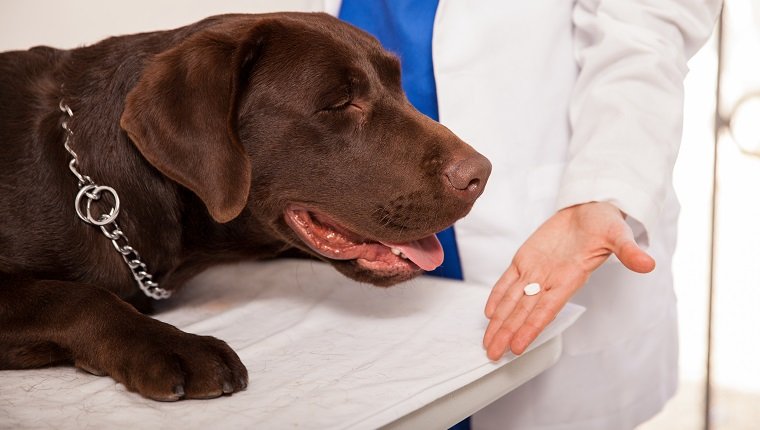Prednisone and prednisolone are steroids that can treat dogs for inflammation and suppress the immune system. They’re glucocorticoids that are stronger than cortisol, which is the steroid stress hormone that a dog’s body produces naturally.
Prednisone is converted to prednisolone in your dog’s liver, but for canines who have poor liver function, a veterinarian might prescribe prednisolone to avoid the need for conversion in the liver. The two have the same essential functions beyond that.
As with all medication, you must rely on your veterinarian for instructions on the correct use. You can get prednisone from Chewy online here so long as you have a prescription from your vet.
Here’s what you should know about the uses, dosage, and side effects of prednisone and prednisolone in dogs.
Uses Of Prednisone & Prednisolone For Dogs

Prednisone and prednisolone treat a wide variety of diseases and disorders in dogs, and vets can prescribe them for many conditions, often as supplemental treatment.
Most often, vets prescribe them to treat Addison’s disease — a condition where a dog’s adrenal glands don’t produce enough natural steroid hormones in the body.
Prednisone and prednisolone also treat autoimmune diseases, such as lupus and autoimmune hemolytic anemia (AIHA), because of their ability to suppress immune system responses. Their immune suppressing qualities make these drugs effective in treating allergic reactions, including those that cause skin irritation or itching.
The anti-inflammatory properties of these drugs make them useful for treatments of many other conditions, including some forms of cancer, arthritis, asthma, inflammatory bowel disease, and skin diseases.
Vets may also prescribe them to treat central nervous system disorders, high blood calcium levels, or shock.
Dosage Of Prednisone & Prednisolone For Dogs

Dosage of prednisone or prednisolone for dogs will vary based on the condition being treated, as well as weight.
It is important to follow your veterinarian’s instructions strictly. The following dosages are simply a guideline for what you might expect to be prescribed for your dog. They should not replace your vet’s advice for your individual dog.
You can get prednisone from Chewy online here so long as you have a prescription from your vet.
For treatment of Addison’s disease, 0.05 to 0.18 mg per pound of body weight should be given to dogs until the condition is under control.
Once the condition is at a manageable level, your vet will likely decrease the dosage to an amount that will allow your dog to maintain healthy steroid levels. This can be as little as 0.009 mg per pound. Prednisone and prednisolone are usually given in these doses once daily by mouth.
To reduce the symptoms of allergies, a dose of 0.25 mg per pound is usually appropriate. Your vet may increase or reduce the dosage based on your dog’s response and whether or not the symptoms have become manageable.
It’s possible your vet will prescribe up to 1 mg to be given throughout the day for allergies. Your vet will strive to find the lowest dose possible while still maintaining your dog’s health.
Other conditions can vary greatly in the dosage needed for treatment.
The method of delivery for the medication can vary, as well. For example, a hypoadrenal crisis may require an injection, while skin conditions like hot spots or itches from allergies may be treated with a topical form of the drugs.
This is why it is important to follow your veterinarians advice and instructions carefully.
Side Effects & Risks Of Prednisone & Prednisolone In Dogs

With short-term use, the risks of side effects associated with prednisone and prednisolone in dogs are minimal.
These side effects might include the following:
- Increased thirst
- Frequent urination
- Increased appetite
- Slower wound healing or infection due to suppressed immune system
- Vomiting
- Diarrhea
- Aggression or behavioral changes
- Lethargy
- Allergic reaction, possibly serious
Long-term use increases the risks of these side effects and may lead to other, more serious conditions.
The side effects that appear with long-term treatment with prednisone and prednisolone in dogs include the following:
- Addison’s disease
- Cushing’s disease
- Diabetes
- Digestive tract ulcers
- Hair loss or dry hair
- Belly distention
- Heart problems or heart attack
Do not stop giving your pet these drugs abruptly, as this can have life-threatening consequences. Ask your vet about weaning your dog off of them slowly.
You should let your vet know if your dog is on any other medications, as these can react badly with prednisone or prednisolone.
A vet should be consulted for dogs who are pregnant, and puppies who are too young should not get these drugs because they can inhibit growth and cause other problems.
Diabetic dogs should also not take them.
Overdose can lead to itching, seizures, loss of hearing, weakness, anxiety, depression, high blood pressure, or heart problems. Follow your vet’s dosage guidelines, and contact your vet if you see signs of any serious symptoms.
Have you ever treated your dog with prednisone or prednisolone? Did you see results? Let us know in the comments below!









